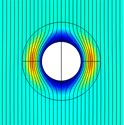Leave no trace
What do you get the wizard who already has an invisibility cloak? How about a wake-less swimsuit? New theoretical calculations published in Physical Review Letters show how a special porous material draped over an object can disguise its movements through water. By directing fluid smoothly around the object, this technology could reduce the viscous drag on ships and other vessels as they plow through the water.
In 2006, David Smith and Yaroslav Urzhumov at Duke University, North Carolina, were able to make a cylindrical object appear invisible to microwaves by guiding the light waves around the object. The “cloak” in their experiment was made of artificial metamaterials, whose light-response properties can be controlled by altering their physical shape. In this case, light entering the metamaterial device was bent in such a way that it emerged as if nothing were in its path. Similar sorts of materials have been constructed to hide objects from sound waves and water waves.
Now, Smith and Urzhumov have expanded the realm of invisibility to fluid flow. In their analytical model, they imagined a sphere sitting in a uniform flow and wrapped in a shell of porous material. In order to make the downstream wake disappear, the researchers varied the fluid resistance (or permeability) of the shell. Their computations showed that the shell’s permeability must be negative in certain regions, which implies fluid acceleration rather than deceleration. In principle, micropumps embedded throughout the porous material could perform the needed acceleration. If such a wake-reducing device could be made, the authors believe it would make ship transportation more fuel-efficient. – Michael Schirber





